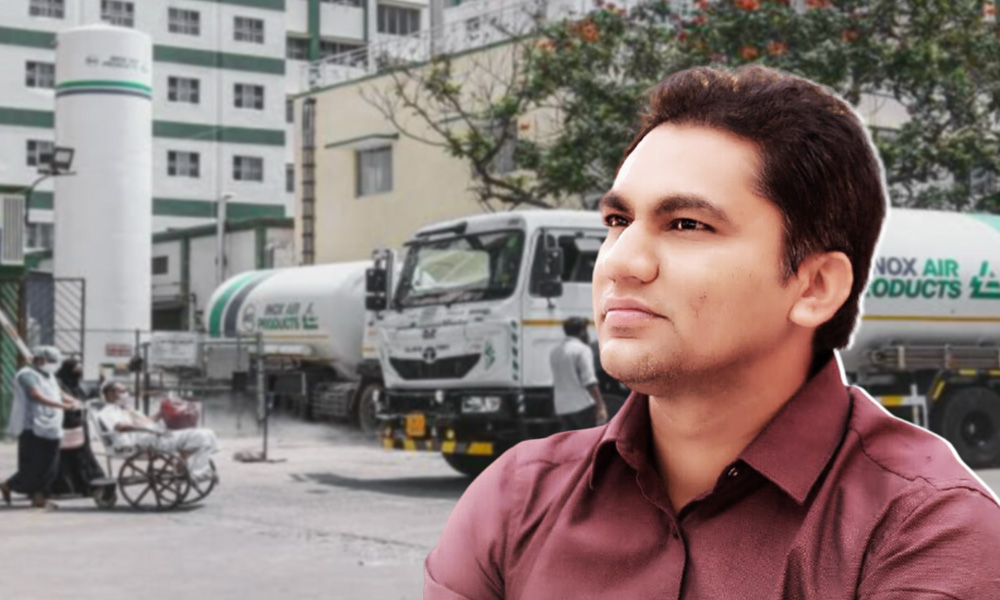
Image Credits: Facebook
If Rest Of India Had Done What Dr Rajendra Bharud, Collector Of Nandurbar Did After The First Covid Wave, There Would Have Been No Shortage Of Oxygen
Writer: Anchal Rana
I am a history enthusiast. I like star-gazing, mountains, reverie and my headspace. Unabashedly an anime lover. I don’t read but write poetry. Books are a relief. Curious to learn the unknown. Prefer the countryside and tea. Above all an aesthete.
Maharashtra, 29 April 2021 6:11 AM GMT
Editor : Anchal Rana |
I am a history enthusiast. I like star-gazing, mountains, reverie and my headspace. Unabashedly an anime lover. I don’t read but write poetry. Books are a relief. Curious to learn the unknown. Prefer the countryside and tea. Above all an aesthete.
Creatives : Abhishek M
" An engineer by profession, Abhishek is the creative producer of the team, graphic designing is his passion and travelling his get away. In more ways than one, he makes the content visually appealing."
Nandurbar district, with a population of 16 lakh, is exhibiting an opposite state of affairs with 150 vacant beds and two oxygen plants that have a combined capacity to produce 2,400 litres per minute.
In Maharastra's Nandurbar district, the pandemic is as severe as the rest of India; the difference has been though in response to the crisis. The nation's healthcare is devastatingly overburdened with the massive surge of cases; Nandurbar district, with a population of 16 lakh, is exhibiting an opposite state of affairs with 150 vacant beds and two oxygen plants that have a combined capacity to produce 2,400 litres per minute.
Owing to its adequate resources and firm health infrastructure, people from neighbouring districts and states (including Madhya Pradesh and Gujarat) have found respite in Nandurbar and are admitting themselves there. With the increased overload, the district has been faring well by not only controlling the positivity rates but also reducing them to a significant 30%. The daily active cases have moderated to 300 from 1200. This accomplishment is largely attributed to Nandurbar's district collector Dr Rajendra Bharud and his team, encompassing administration staff, doctors, and volunteers. The tribal district didn't have a single liquid oxygen plant or tank before the COVID-19 breached the Indian borders last year. In September 2020, when there was a contraction in Covid 19 cases, Nandurbar collector Dr Rajendra Bharud established an oxygen plant at the district hospital at an expenditure of 85 Lakhs. In January and February, early this year, he set up two ore oxygen plants. The first wave of the pandemic in Nandurbar saw 190 patients, which encouraged Mr Bharud to make the district self-reliant with regards to oxygen requirements.
Rest Of India Was Getting Back To Normal, Nandurbar Was Getting Ready For Next
"I believed that soon a time could come when there could be a desperate need for oxygen and so we set up a plant with a capacity of 600 liters per minute when there weren't many cases and we had enough time on our hands," said Dr. Bharud, over a telephonic call to THE WEEK. As the cases were declining post first wave coupled with promised vaccination drives by the Centre, many cities and villages were disassembling their Covid 19 facilities. As opposed to this Mr. Bharud did not waver and had the foresight in developing the facilities and the infrastructure even more in case of resurgence.
"As cases were going down in India, I saw America and Brazil face a massive surge. I wanted to be prepared in case we witnessed something similar. So in September 2020, we installed the first oxygen plant in the district, which had a capacity to produce 600 liters per minute, even though our highest single-day spike was only 190 cases. In March, we installed another plant. As single-day cases touched 1,200 in April, we started preparing to install the third one. Soon, we will have plants with a combined capacity of 3,000 liters per minute," Dr. Rajendra, who holds an MBBS degree, tells The Better India.
"We utilized the funds from the district planning and development and the state disaster relief fund because the point is to not let a single person die because of the want of oxygen," he said. There was a conversion of places like schools and community halls into COVID-19 centers. The administration set up 7,000 beds just for isolation, and 1,300 beds were equipped with ICU or ventilator facilities. 27 ambulances for patients and 2 ambulances for moving the dead bodies were arranged. One of the earliest steps taken was the creation of control rooms to systmatically crub the panic and gudie the citizens , esnuring people were not lost in search of beds.There was also a training of local doctors and medical personnels to perform vital procedures such as incubation and monitoring oxygen levels.
Dr. Rajendra has ensured that there is a swift regulation of vaccination drives in the tribal district despite the lack of awareness on the matter.Of the 3,00,000 individuals aged above 45, one lakh have already received the first dose. "Instead of calling people to us for vaccination, we allotted 16 vehicles to every part of the district to give the vaccine. This way, people didn't have to travel in hilly terrains. We roped in teachers and sarpanches to spread the word about the seriousness of the situation, and it worked," adds Dr Rajendra.
Inspiration Is An Understatement
Dr Rajendra Bharud's vision has undoubtedly impeded the worst of the pandemic as the nation is gasping for oxygen. He is an inspiration to the country and strikes an epitome of hard work. He received his medical degree from Mumbai's KEM hospital and Seth GS Medical College and is an IAS officer of the 2013 batch. He was born to tribal parents in the remote village of Samode in the taluka of Sakri in Nandurbar. He was raised by his mother in a small hut built by sugarcane leaves. He studied in a Zilla Parishad school and climbed up his way through merits and scholarships. Justifying his position as district Magistrate of Nandurbar, he had launched several developmental initiatives for the region, such as bringing 40,000 families under the umbrella of ration scheme and enrolling more than 65000 under the Mahatma Gandhi National Rural Employment Guarantee Act (MGNREGA).
The far-sighted and insightful approach of Dr Rajendra is commendable. The Maha Vikas Aghadi or the MVA government has asked the collectors in the state to follow the Nandurban pattern for boosting the oxygen supply at the hospitals. Now the MVA government is trying to implement "the Nandurbar pattern in the state", as per the reported statement made by Chief Secretary Sitaram Kunte. The tally of cases in Maharastra is soaring, with 48,700 fresh cases and 524 deaths on Tuesday. It is the worst-hit state in the country, with variants of the virus gnawing on the hope. Instances like Nandurbar rekindle some hope in the country to surmount the horrendous pandemic.
Also Read: Patna: Govt Covid Facilities Left With 2-Day Of Oxygen Stock
 All section
All section














